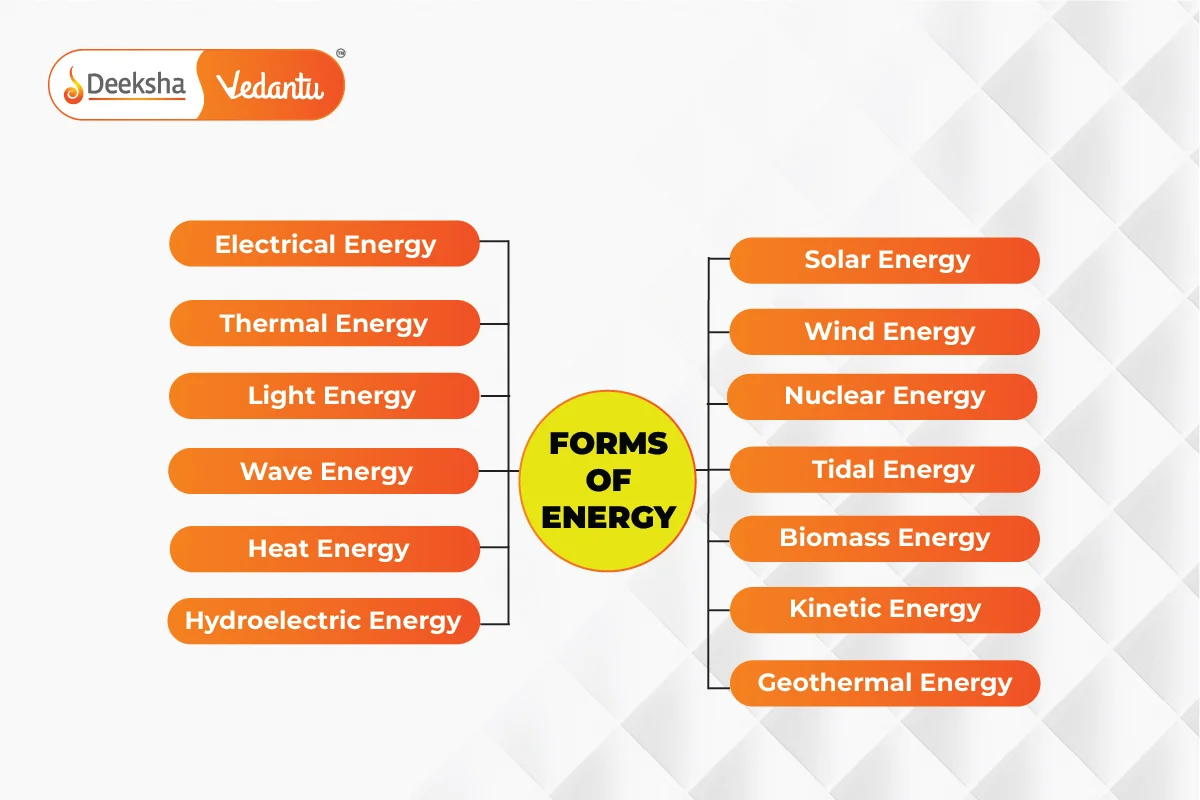Energy permeates every aspect of our daily lives and the universe at large. Defined in physics as the ability to do work, energy exists in various forms, all of which can be categorized as either kinetic or potential. This comprehensive guide will delve into the definitions, types, and fundamental principles of energy.
What is Energy?
Energy is defined as the ability or capacity to do work. In physics, energy is a fundamental concept that describes how objects interact, move, or change their physical state. It is a scalar quantity, meaning it has magnitude but no direction. The SI unit of energy is the .

Types of Energy
Energy comes in various forms, which are classified into two broad categories:
1. Kinetic Energy (KE):
Kinetic energy is the energy possessed by an object due to its motion. Any object that moves has kinetic energy. The amount of kinetic energy depends on the mass of the object and its velocity.
- Formula for Kinetic Energy:
Where:is the kinetic energy,
is the mass of the object,
is the velocity of the object.
- For example, a moving car, a running athlete, and a falling object all possess kinetic energy.
2. Potential Energy (PE):
Potential energy is the energy stored in an object due to its position or configuration. The most common type is gravitational potential energy, which is the energy stored in an object when it is positioned at a height above the ground.
- Formula for Potential Energy:
Where:is the potential energy,
is the mass of the object,
is the acceleration due to gravity (
),
is the height of the object above the ground.
- For example, water stored in a dam, a book placed on a shelf, and a compressed spring all possess potential energy.
Mechanical Energy
Mechanical energy is the sum of kinetic energy and potential energy in a system. It represents the total energy possessed by an object due to both its motion and position.
- Formula for Mechanical Energy:
Mechanical energy is conserved in systems where only conservative forces (like gravity) act. This concept is widely applied in the motion of objects, such as pendulums and roller coasters.
Law of Conservation of Energy
The law of conservation of energy is a fundamental principle of physics, stating that energy can neither be created nor destroyed; it can only be transformed from one form to another. The total energy of an isolated system remains constant.
For example:
- In a pendulum, energy continuously transforms between kinetic and potential energy as the pendulum swings back and forth, but the total mechanical energy remains the same.
- When a ball is thrown upward, its kinetic energy decreases as it rises, while its potential energy increases. At the highest point, the ball has maximum potential energy and zero kinetic energy. As it falls back down, potential energy converts into kinetic energy.
Forms of Energy

Kinetic Energy (Energy Due to Motion)
Kinetic energy is the energy possessed by an object because of its motion. Any object in motion has kinetic energy, which increases with the speed and mass of the object.
- Mechanical (Translational) Energy:
The energy of an object in linear motion. Example: A moving car, a flying airplane. - Rotational Energy:
The energy possessed by an object due to its rotation. Example: A spinning top, the blades of a fan. - Thermal Energy:
The energy associated with the random movement of particles in a substance, often referred to as heat. Example: Boiling water, a hot cup of tea. - Sound Energy:
The energy carried by sound waves, which is produced by vibrating objects. Example: Music from a speaker, the sound of a ringing bell. - Electrical Energy (Kinetic aspect):
The energy carried by moving electric charges (electric current). Example: Electricity flowing through a wire, an electric motor. - Radiant (Light) Energy:
The energy carried by electromagnetic waves, such as light or X-rays. Example: Sunlight, light from a bulb.
Potential Energy (Energy Due to Position or Configuration)
Potential energy is the stored energy in an object because of its position, condition, or configuration. It is energy that has the potential to be converted into kinetic energy.
- Gravitational Potential Energy:
The energy stored in an object due to its height above the ground. Example: Water in a dam, a book on a shelf.
Formula:
Whereis mass,
is acceleration due to gravity, and
is height.
- Elastic Potential Energy:
The energy stored in objects that can be stretched or compressed. Example: A stretched rubber band, a compressed spring. - Chemical Energy:
The energy stored in the bonds of chemical compounds. Example: Energy in food, fuel, or batteries. - Nuclear Energy:
The energy stored in the nucleus of atoms. Example: Energy released during nuclear fission or fusion. - Electrical Energy (Potential aspect):
The energy stored due to the position of charged particles. Example: A charged capacitor, lightning before it strikes.
The below table will help you easily categorize the forms of energy between Kinetic Energy and Potential Energy.
| Kinetic Energy | Potential Energy |
| Mechanical (Translational) Energy | Gravitational Potential Energy |
| Rotational Energy | Elastic Potential Energy |
| Thermal Energy | Chemical Energy |
| Sound Energy | Nuclear Energy |
| Electrical Energy (current) | Electrical Energy (stored charge) |
| Radiant (Light) Energy |
Examples of Energy Conversion
Energy can be converted from one form to another in various processes. Here are some examples:
- Electric Fan: Electrical energy is converted into mechanical energy to rotate the fan blades.
- Photosynthesis: Plants convert light energy from the Sun into chemical energy stored in glucose.
- Hydroelectric Power: Water stored in dams has potential energy, which is converted into kinetic energy as the water falls and spins turbines, generating electrical energy.
Energy and Work
Energy and work are closely related concepts. In physics, work is done when a force is applied to an object and it moves in the direction of the force. The amount of energy transferred when work is done is equal to the work itself.
- Formula for Work:
Where:is the work done,
is the force applied,
is the displacement of the object in the direction of the force.
The unit of work is the , which is the same as the unit of energy.
Applications of Energy
Energy is vital in every aspect of life, from powering our homes and vehicles to enabling physical activities. Some common applications include:
- Hydroelectric Power Plants: Convert potential energy of stored water into electrical energy.
- Solar Panels: Convert radiant energy from the Sun into electrical energy.
- Batteries: Store chemical energy and release it as electrical energy to power devices.
- Mechanical Devices: Machines like engines convert chemical energy in fuel into mechanical energy to perform work.
FAQs
Conserving energy is crucial for sustaining natural resources, reducing environmental impact, and maintaining ecological balance.
Renewable energy sources are those that can be replenished naturally over short timescales and include solar, wind, hydro, and geothermal energy.
The relationship between energy and mass is famously explained by Einstein’s theory of relativity, specifically through the equation:
Where:
is the energy,
is the mass of the object,
is the speed of light in a vacuum (
).
While kinetic and potential are the primary categories, energy can manifest in various specific forms like nuclear, magnetic, or ionization energy, each associated with particular physical phenomena.
Energy is the capacity to do work, while power is the rate at which work is done or energy is transferred.
Energy transfer occurs when work is done on an object, transferring energy from one form to another (e.g., from potential to kinetic energy).
Mechanical energy is the sum of an object’s kinetic and potential energy.
No, according to the law of conservation of energy, energy cannot be created nor destroyed; it can only be converted from one form to another.
Kinetic energy is the energy an object has due to its motion, while potential energy is the stored energy due to an object’s position or configuration.
Related Topics
- Difference between AC and DC
- Scattering Of Light
- The Human Eye And The Colourful World
- Concave Mirrors and Convex Mirrors
- What is Hypothesis?
- Refraction Of Light
- Velocity
- Defects Of Vision And Their Correction
- Projectile Motion
- Bernoullis Principle
- Mirrors
- Electricity
- Refraction Of Light Through A Prism
- Reflection Of Light
- Domestic Electric Circuits








Get Social